Transition: A New Class
Supporting Transition to a New Class
Class changes in September are a huge source of anxiety for all involved. There are a range of activities you can undertake to make this transition between classes easier. I have written a blog about supporting learners with day-to-day general transitions and this one on supporting Autistic children with class transitions.
This post aims to build on these previous posts. It will provide some useful strategies and a pack of free printable transition resources to use when transitioning pupils into the next stage of their education. I work with Autistic children and those with SLD however these strategies can be effective with learners at all ages and stages of development. I have seen how some are effective for individuals and how others require adapting. Provided below are examples of the resources I have used to support transitions. These are in word format so you can easily adapt them to your needs.

All resources are free but please help us by sharing these articles. Use this link if you are planning on buying anything on Amazon and we will get a small contribution to our hosting costs: https://amzn.to/2IeNdFX
Notice that most of these resources support children and young people using visuals. There are many studies and books that stress the importance of visuals for those with a special educational need or disability (SEND). You need not be a graphic designer to facilitate the creation of visual resources. Widgit online is a super simple tool (with a free trial) that you can use to create a whole range of visuals quickly and easily.
5 Free Printable Transition Resources.
When supporting children and young people with SEND Visual supports are the first specialist teaching strategy that you should implement. Often finding an effective system is a case of trial and error and persevering. Scroll down for the free downloadable resources essential in supporting transitions of all types.
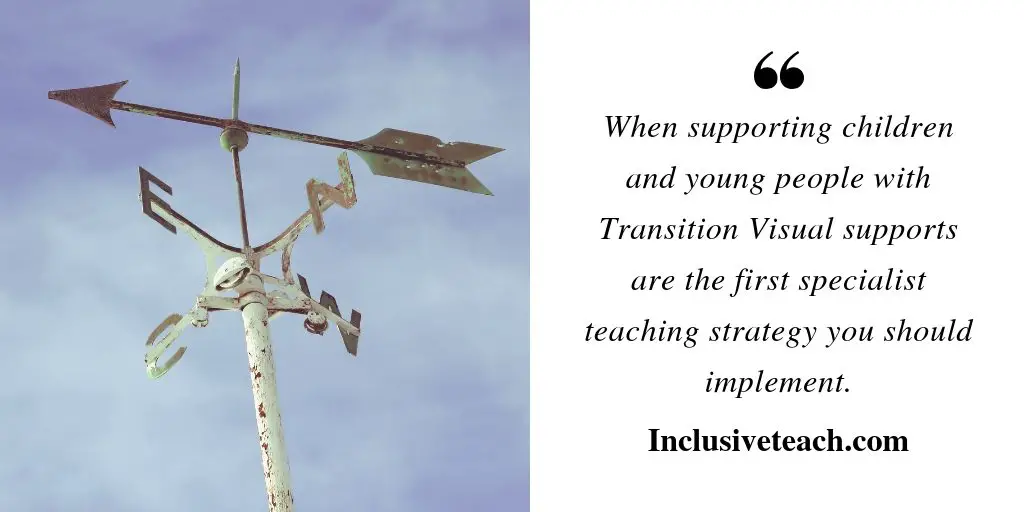
Transition Symbol/Visual Key Ring
Key rings are simple to make and keep in your pocket. This ensures you always have access to key visuals. The challenge is choosing the core essential vocabulary to include. Many of these are symbols, to support transitions photos may be more appropriate – why not try both and keep the most effective?
[bctt tweet=”Top Tip: Use photos of people rather than places when transitioning. It is often more effective if the child knows who they are going to see rather than where.”]
Examples of key vocabulary include:
- Stop
- Good
- Home
- New class
- New Teacher (use a name if appropriate)
- Friend
- Snack (or food)
- Ear Defenders
- Go Back
- Help
- Angry
- Leave me alone
- Happy
- Sad

These symbols or images act as an immediate visual reminder for children and young people to guide them to their next activity reducing anxiety. There is a dual purpose to these handy visual prompts. Firstly, the adult uses these to deliver clear instructions or reinforce next steps, second, the child will use them to show preferences. Usually, the adult carries them, let the child take them if needed. I would always recommend using these to structure a transition visit to a new classroom or to meet new friends.
Now and Next/First and Then boards
Top Tip: Keep language to a minimum. Using visual supports can support the learning of new words faster. Instead of saying “FIRST, we are going to the sensory room and THEN we are going to make a snack” just say “FIRST Sensory Room, THEN Snack”.
Similar to the transition key ring but reduced down to two symbols/images. Nothing I have used comes close to being as effective a transition tool as the “First Then” board. You can extend to three if the child can cope with this/would enjoy using two or more. A Now and Next board is a mini-schedule that you/the child refer to whilst transitioning between activities. In the example above we are using the board to transition between the sensory room and snack. One of these is a place and one is an activity but if you wanted, you could use “class”. I have found that when ending a motivating activity it is good to plan a transition to an equally motivating activity/place.
See the free downloadable examples below for some options. I prefer to use plain card/corex. One example included uses editable background colours to show each element. Usually, these use laminated images and velcro with a bank of symbols available somewhere else (or stuck on the back). I have just quickly printed off a paper copy pre-filled with the images for an unplanned transition/issue. As long as the child can recognise the images/words used don’t get hung up on the subtleties.


I have also used this in place of a more formal “working towards” visual. Here the first activity is usually a work task of your choosing and the “next” is a preferred activity. I find it easier to manage to have one system of visuals than multiple as often the now and then board compliments a PECS system (do not take the PECS symbols to replace lost now and next symbols!).
Daily Visual Schedule
A schedule is a visual representation of the expected daily routine that enables children to feel secure when transitioning. Included for download are two examples the first uses larger and should use velcroed images to construct the activities of the day. Type directly into the second version and print, this has the benefit of being set when the situation is not flexible. However, unexpected changes often cause stress and anxiety. Therefore if you type and preprint a schedule make sure you have a backup system to show changes. I would recommend using a set daily schedule only as a starting point for giving the child an element of self-advocacy over the makeup of their day.

When you use the schedule, it is important to remove or tick off each element as you complete them.
A visual schedule is perfect for introducing a new class or teacher. In the example below I have included a picture of a person with the activity. If the transition is spending time in another
Visual schedules form part of the TEACCH structure. If you are following a TEACCH system these work by taking the child to the visual schedule when they complete and activity. They then remove the activity symbol or image and place it in the “Finished” basket. If the child is not ready for a schedule or becomes distressed by a symbol on it, then reduce the schedule to three/four activities. I have found that the “Home” symbol can distress the child and lead to a desire to rush through activities to reach it.
Social Stories for Transition
I think social stories are great for supporting people with any out-the-norm activity, experience or event.
” A social story should be a core element of your total communication environment.”
Joe White
Provide a social story as standard for any planned transition. Lynn McCann’s book “Stories that explain” comes with a DVD of editable stories for many commonly found occasions.
I have never found a standard story downloaded from the internet as effective as writing your own. If you write your own, you can create a story personalised to the child including their picture and the real place they are visiting. Carol Gray’s site has a sampler of social stories that should give you some ideas of the things you should include in each story.
Use social stories for the transition by including photographs of the new teacher, classroom, teachers, support staff, toilets, and where possible new classmates. This will reduce the anxiety a child will face when trying to make sense of the new environment. We can never overestimate familiarity as a transition tool. In my previous post about transition, I mentioned associative memory and the importance of making sure pre-transition visits are positive. I want to reinforce the importance of letting the child process the information in the social story. If they want to read it 50 times let them!
Hero Cards/Transition Cards
Sometimes a social story contains too much information and the child needs to process each piece of information separately. I first used “Hero Cards” to teach classroom rules and expected behaviour. Then I used them to give a child specific facts about an upcoming change in class. In the free downloadable example below I have included a number of editable templates. The hero aspect was initially based on a motivator (Marvel Comics) and the theory that a rule would be more effective if it came from Spiderman than me.
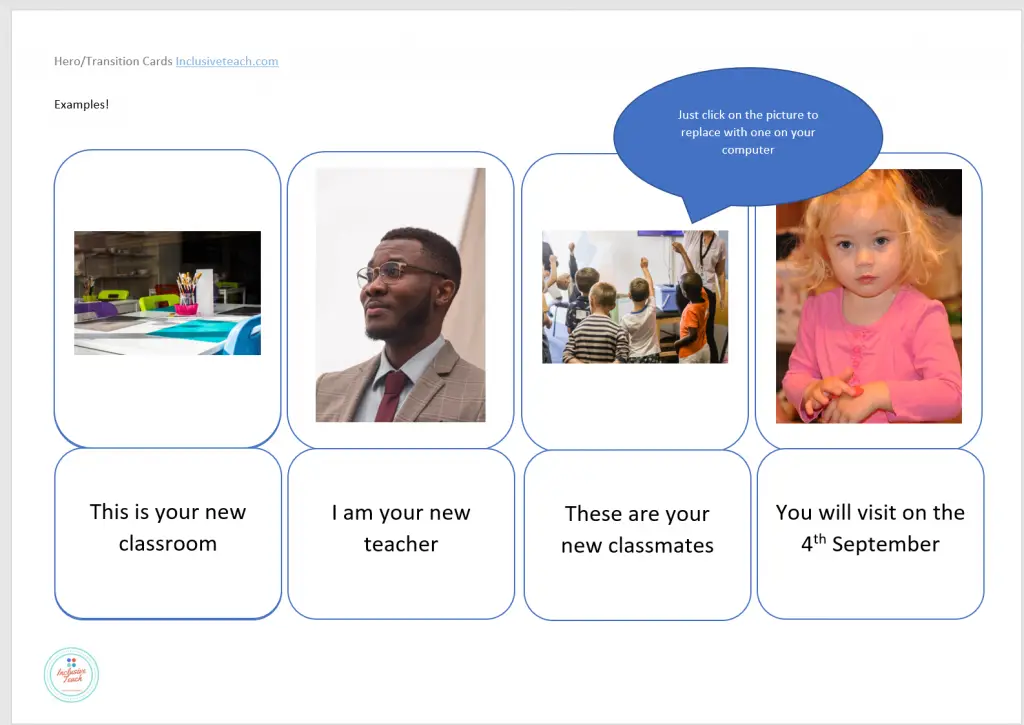
Update: The “Goodbye” End of Year Transition version.
July and September can be times of great stress for young people. The anxiety around changes to class can be overwhelming. During my time as a special education teacher, I have found that the work around transition too often focuses on preparing for the new and not saying goodbye to the old, the familiar, that which will be missed.
Whilst we can and should acknowledge the upcoming change why not adapt and spin these resources to support saying goodbye? I have adapted and uploaded the “Hero Cards” as a template
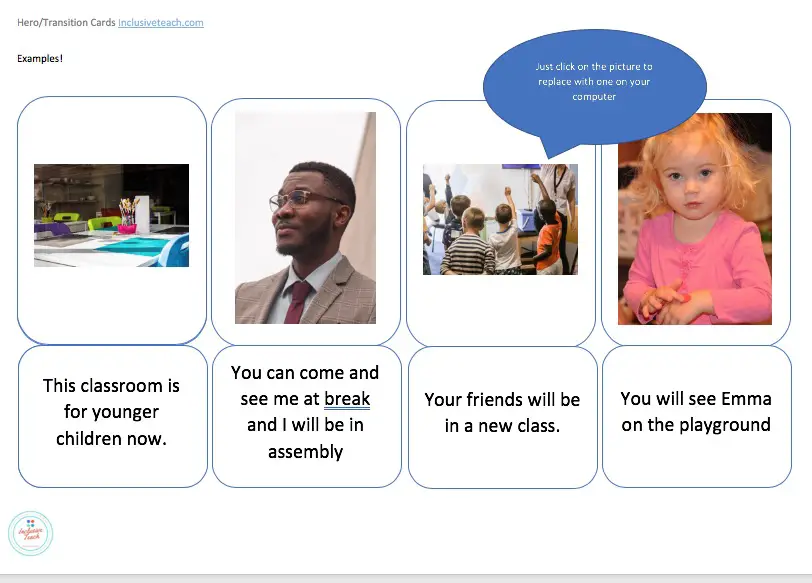
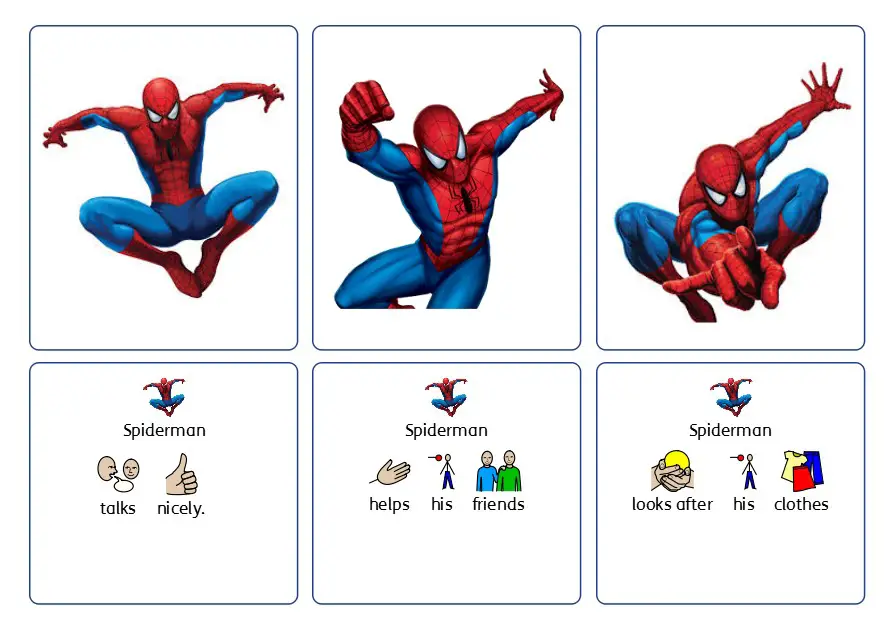
Transition Resource Download
Download the Zip file with all featured resources here, you will need inPrint3 to edit the .ipdoc files everything else is in word or PDF, all are free but clicking the link below really helps us pay our hosting costs: Free Printable Transition Resources
I hope these are of you to you. I really would appreciate a share of these moving to a new class transition visual resources if you liked them Drop me a comment if you have any thoughts on this article.
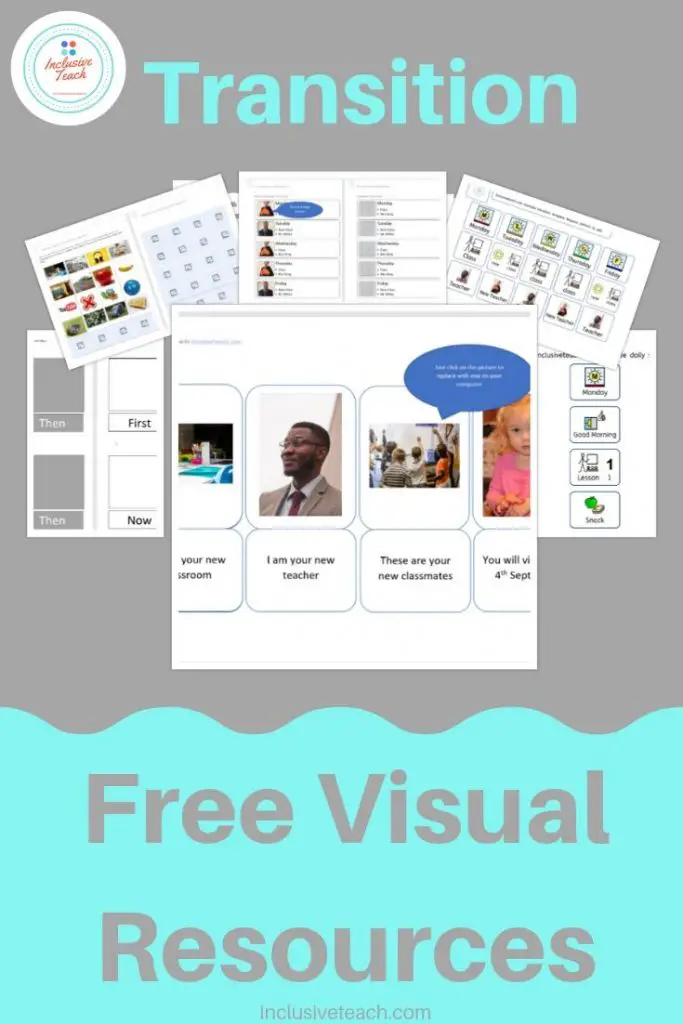

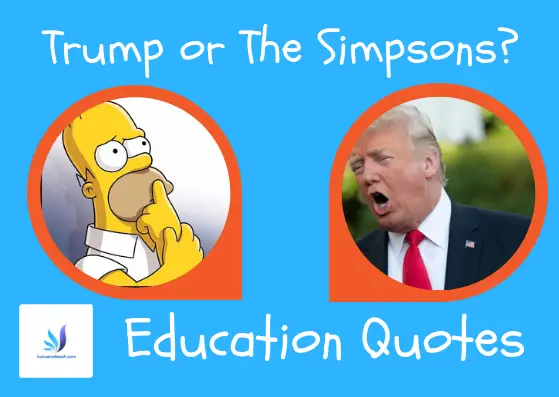
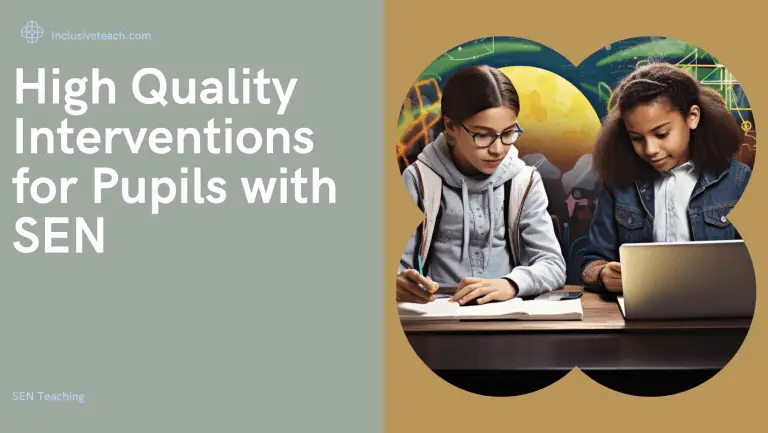

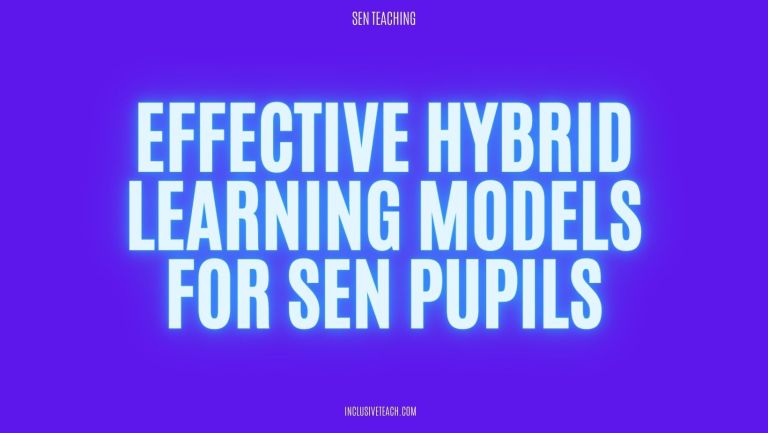
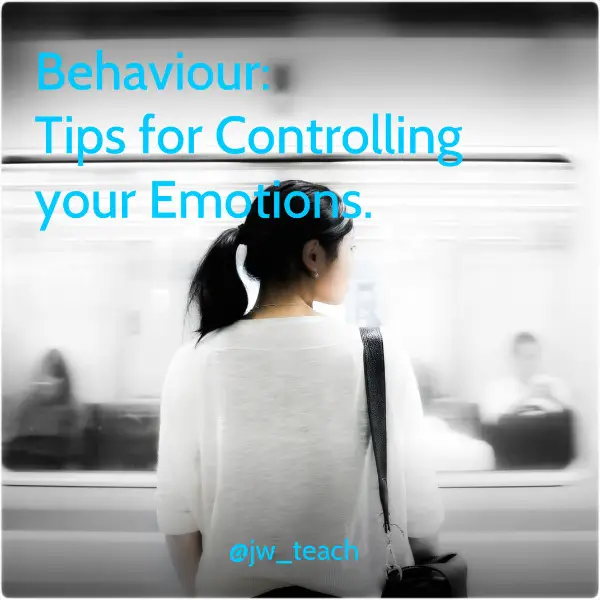
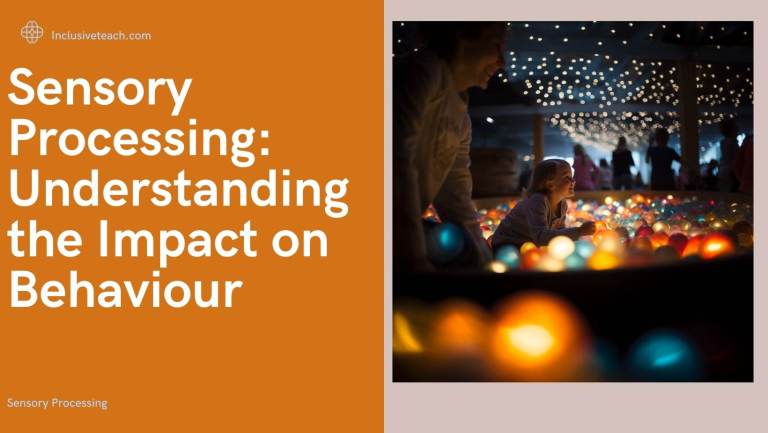
Thank you for sharing all these great resources for transition. We have really focused on transition this year with teachers working very closely with the children’s new teacher to ensure all strategies have been past on.